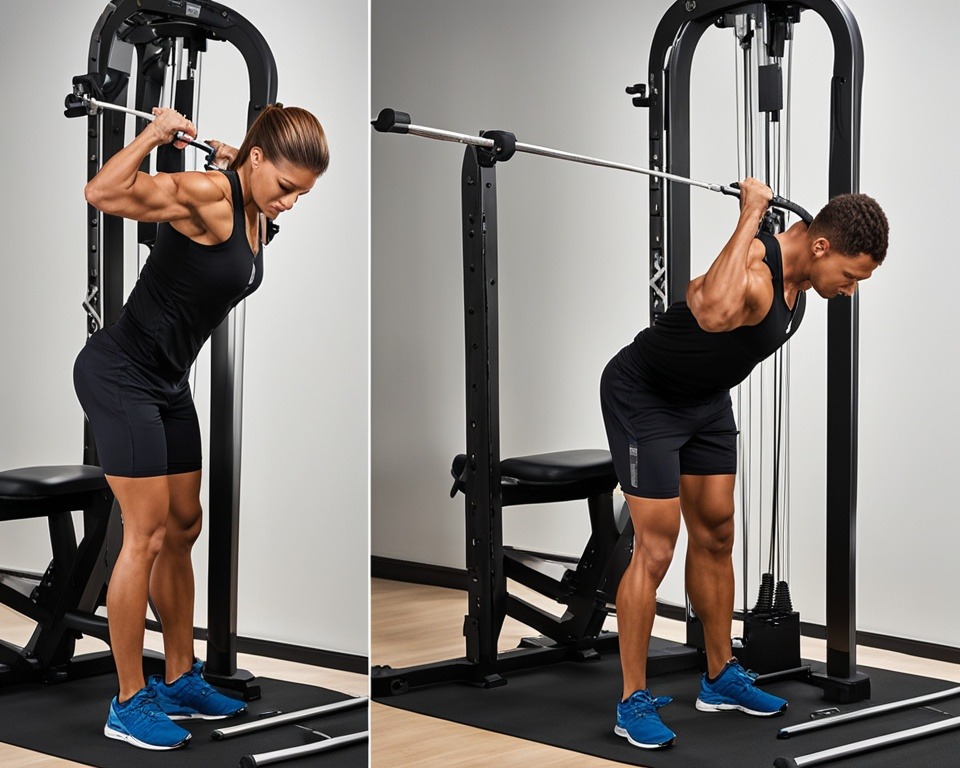Do you know how many times people repeat exercises in a workout? On average, it’s thousands of times! This shows the huge role reps play in our workouts.
Reps stand for repetitions. It’s how many times you do an exercise before resting. No matter if you lift weights, do push-ups or use gym machines, reps are key to a good workout.
Why are reps so important, you might wonder? Here, we’ll tell you all about it. You’ll learn how reps help build muscle and boost your fitness. We’ll dive into why they make our workouts better.
Understanding Reps and Sets in Strength Training
In strength training, it’s key to get reps and sets. Reps are how many times you do an exercise before a pause. Sets are a group of these reps done together with breaks in between.
The number of reps you do depends on what you want from your workout. Doing 8-12 reps in a set helps with muscle endurance and growth. For just getting stronger, doing 1-5 reps in a set with heavier weights is better.
Why do reps matter in fitness? Doing reps boosts your muscles’ strength and endurance. You get stronger by lifting heavier as you add more reps. Doing reps right also keeps you from getting hurt.
It’s vital to do reps correctly for the best workout. This means keeping good form and moving smoothly. Doing reps right targets the muscles you want to work without hurting yourself.
It’s also important to know about rep ranges. This is the number of reps you do for an exercise. Doing fewer reps with more weight builds strength. Higher rep counts with less weight boost muscle endurance. Knowing about this lets you set up your workout for your goals.
Mixing up rep ranges through periodization can help a lot. This keeps your muscles from getting too used to the same thing. It pushes your body to keep improving.
Basically, knowing about reps and sets is major in strength training. It helps match your routine to what you want to achieve. The right reps, correct form, and varied ranges make your workouts more effective.
The Importance of Proper Form and Technique
Doing reps correctly is super important. It keeps you safe and helps your workout really work for you. Let’s look at why form and technique matter in your fitness training. Firstly, proper rep technique ensures that you are engaging the correct muscle groups and maximizing the effectiveness of each exercise. By using the correct form, you are targeting the intended muscles and minimizing strain on other parts of your body. This means you’ll be able to lift heavier weights or perform more challenging exercises over time, leading to increased strength and muscle growth.
Phases of Action During a Rep
Each rep has important phases that are key for effective muscle use. You need to know about the concentric, eccentric, and isometric phases. By understanding and controlling these stages, your muscles will work better and grow stronger. When it comes to optimizing your workout reps, understanding the different phases of action is crucial. Each phase – the concentric, eccentric, and isometric – plays a vital role in building muscle and maximizing your fitness gains. The concentric phase is the one we often associate with the actual movement or lifting of weights. This is when the muscle contracts and shortens, generating force to overcome the resistance. It is during this phase that the targeted muscle is actively engaged, resulting in both strength improvements and muscle growth.
Breathing and Movement Control
How you breathe and move is also crucial. Breathing right keeps your core strong and your mind sharp. Remember to breathe out when you push hard and in when you relax. This technique makes your movements smoother and better for your body.
Full Range of Motion’s Impact
Doing exercises with a full range of motion is vital. It makes sure your muscles work hard and grow. It also boosts your flexibility and keeps your joints healthy. Always try to use your body’s full motion to see better results and stay injury-free.
In short, form and technique are key for safe and effective workouts. Focus on each rep’s action phases, how you breathe, and your body’s full movement range. These steps will make your training better for your goals and keep you safe.

What Are Reps in Exercise and Their Role in Muscle Development
Reps are short for repetitions and are key for building muscle and strength. They make your muscles better over time. Knowing how reps affect muscle growth helps in planning your workouts.
Reps help beyond just muscle building. They boost your fitness and stamina. It’s crucial to do reps with the right technique to get the most out of them.
Doing reps correctly is about doing each one with the right movement and control. This way, you hit the muscles you want without risking injury. Focusing on the form helps each rep work better and avoids strain.
More reps over time make your muscles work harder and grow. It’s an important method for muscle development.
The ideal rep range for growth is usually 8 to 12 per set. This range helps muscles get bigger and stronger. Still, some muscles respond better to different reps. So, mix things up for the best results.
It’s essential to track your rep’s progress to see muscle development. By keeping a record, you can set and meet future goals. This helps keep your workouts effective and challenging for muscle growth.
Variety in Strength Training: Machines, Free Weights, and More
To build a solid strength training routine, mix up your exercises. Work on various muscle groups with machines, free weights, and functional exercises. Also, try out tools like resistance bands and using your own body weight.
Machine-based Exercises
Machines are perfect if you’re new to working out or need extra help. They guide your movements with a set range. You’ll find clear how-tos and tips to get the best results. Machines let you focus on one muscle group at a time. Plus, they adjust to fit different people’s sizes and strengths.
Free Weights and Functional Training
Free weights like dumbbells let you move more freely than machines. You need to balance and control the weights, which helps your body work as it does in the real world. This improves not just strength but also how steady you are. Working with free weights can make your whole body stronger, especially your core.

Alternative Equipment: Resistance Bands and Bodyweight
For something you can take anywhere, try resistance bands and bodyweight exercises. Bands offer ways to make your muscles work harder, both for your arms and legs. They’re light and easy to carry, so you can exercise no matter where you are. With bodyweight exercises, use yourself as resistance. They don’t need any equipment and are great for getting stronger and more limber.
Try a mix of machines, free weights, and different gear to keep your workouts fun and effective. Try out various exercises and tools to keep challenging yourself. This way, you’ll work different muscles and avoid getting tired of the same old routine.
Designing Your Workout: Reps, Sets, and Weight Recommendations
When you’re making your workout plan, knowing about reps, sets, and weights is key. This helps you customize your routine to reach your fitness goals and get the best results.
Determining the Right Number of Reps
The right number of reps depends on what you want to achieve. For strength and bigger muscles, aim for 6-8 reps with heavy weights. Make sure your form is correct.
When toning muscles, 8-12 reps per set works better. You’ll find a good mix of challenge and shaping your muscles this way.
Want better endurance and heart health? Go for 12-15 reps or more. This tests your stamina and increases your endurance slowly over time.
Optimizing Workout Reps for Maximum Effectiveness
Using different rep ranges boosts overall fitness. Include both high and low reps to work on different muscle parts. This encourages muscle growth in different ways.
Always keep your form strict to avoid injury and get the best results. Move slowly, breathe right, and make sure each rep is done correctly.
Incorporating Reps into Your Training Plan
Exercise will change depends on the individual so include the right number of reps in every exercise for your plan to be effective. Begin with a small number of reps to warm up your muscles. Increase rep numbers in the following sets.
Try adding supersets or drop sets to your routine for a different challenge. Such methods change the usual routine, keeping your muscles working hard.
Keeping track of your reps helps you see how your strength and fitness are improving. Use a notebook or a fitness app to note down your reps for each workout. This way, you can set goals and modify your plan as you get stronger.
So, designing your workout plan with the right reps, sets, and weights is crucial. Figure out the best rep numbers, make your workouts effective, include a variety of exercises, and keep track of your progress. Doing this will craft a routine that moves you nearer to your fitness dreams.
Understanding reps and sets is key to making your strength training better. This article showed how adding reps to your exercises can help your fitness journey. It’s not just about the number; it’s about knowing what each rep does for you.
Doing reps correctly is very important. It makes sure each exercise works well and keeps you safe. Always try to control your moves. And make sure you move your body through its whole range.
Think about your goals when planning your workouts. More reps can boost your strength. And the right number of reps for muscle growth is crucial. Planning well helps you get what you really want from your training.
Following this advice will make your training better. Always pay attention to how your body feels. And be ready to change your plan if needed. With focus and smart work, you can reach your fitness dreams.
FAQs
What are reps in exercise?
A rep is short for repetition. It’s the number of times you do an exercise in a row. Reps are key in strength training. They help build muscle and boost your fitness level.
How many reps are there in a set?
The amount of reps in a set depends on what you’re trying to achieve and the type of exercise. You might do as few as one or as many as 20 or more. Picking the right rep number is crucial for meeting your workout goals.
What are the benefits of doing reps in fitness?
Doing reps boosts many parts of your body, like making your muscles stronger and tougher. It also shapes your muscles and ups your bone strength. Doing reps well helps you move safely during exercises.
How do I determine the right number of reps for my fitness goals?
To decide on the right reps, look at your fitness stage, the routine, and what you want in the end. It’s smart to talk to a fitness expert. They can craft a workout plan with the exact reps needed for you.
What is the role of reps in muscle development?
Reps help muscles by tearing muscle fibers, which then rebuild stronger. The number of reps and the weight you lift matter. They decide if you get stronger or if your muscles get bigger.
What are the different options for strength training exercises?
Train your muscles with machines, free weights, body exercises, and more. Each way works muscles in different ways. Using various methods improves your overall muscle power and shape.
How can I optimize my workout reps?
Getting the most out of your reps means nailing the right form and lifting the correct weight. Add more reps slowly. Mixing up your rep numbers will push your muscles to grow and get stronger.
